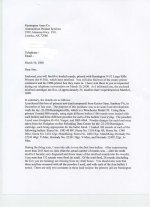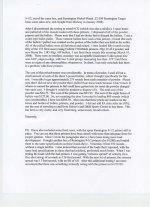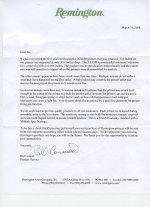I
Im_leary
Guest
I am providing this information as a service to the members of the Benchrest Forums so please take these observations in the context intended... as information, not as a spark for a pissing-contest.
In summary (you may read the details in my attached letter to Remington) I purchased a brick of Remington 9-1/2 primers from my local dealer in December, 2007. I loaded 800 of these primers into .22-250 rounds over the next few months. When the weather improved to the point that I felt I could do some meaningful load testing, I took these rounds to the range for some intensive testing. What I found was 26 misfires in the first 132 rounds.
Additional relevant information is that the rifle is my old Winchester Model 70 National Match rifle. Prior to being a 22-250, it has worn four different .308 barrels. In the 12,000+ rounds of match competition and practice, it has never, ever, misfired. After I disassembled the balance of the 800 rounds loaded with the questionable lot of Remington 9-1/2 primers, I have loaded and fired 386 rounds. These 386 rounds were loaded using both a new lot of Remington 9-1/2 and Federal 210M primers. There were no misfires whatsoever.
In summary, every misfire encountered was with a round using a Remington 9-1/2 primer from lot #1502. There have been no other misfires before or since.
You will also find Remington's response to my letter attached. Essentially, Mr. Conrad said my gun is broken, have it checked by a gunsmith... and oh, here is $5.00 for your trouble. I called Mr. Conrad and asked him to share the findings of his investigation. Suffice to say, he would not answer my questions. When he reiterated his position that my gun was malfunctioning, I pointed out that his premise; that there is nothing wrong with lot# 1502, even though this malfunction happened 26 times and only when using lot #1502, he became quite angry. When I hung up the phone on him he was still ranting, "... if you know all those statistics, then I guess you know everything there is to know and...". In deference to Mr. Conrad, I do not know everything there is to know... but after spending an entire career as an engineer, I do know a modicum of the science of probability and statistics. That knowledge of statistics would lead me to believe that a 19.7% failure rate, with one specific lot of primers, and in light of a 0.0% failure rate exhibited before and after using that particular lot of primers, the chance that there is a problem with those primers is statistically significant.
In summary (you may read the details in my attached letter to Remington) I purchased a brick of Remington 9-1/2 primers from my local dealer in December, 2007. I loaded 800 of these primers into .22-250 rounds over the next few months. When the weather improved to the point that I felt I could do some meaningful load testing, I took these rounds to the range for some intensive testing. What I found was 26 misfires in the first 132 rounds.
Additional relevant information is that the rifle is my old Winchester Model 70 National Match rifle. Prior to being a 22-250, it has worn four different .308 barrels. In the 12,000+ rounds of match competition and practice, it has never, ever, misfired. After I disassembled the balance of the 800 rounds loaded with the questionable lot of Remington 9-1/2 primers, I have loaded and fired 386 rounds. These 386 rounds were loaded using both a new lot of Remington 9-1/2 and Federal 210M primers. There were no misfires whatsoever.
In summary, every misfire encountered was with a round using a Remington 9-1/2 primer from lot #1502. There have been no other misfires before or since.
You will also find Remington's response to my letter attached. Essentially, Mr. Conrad said my gun is broken, have it checked by a gunsmith... and oh, here is $5.00 for your trouble. I called Mr. Conrad and asked him to share the findings of his investigation. Suffice to say, he would not answer my questions. When he reiterated his position that my gun was malfunctioning, I pointed out that his premise; that there is nothing wrong with lot# 1502, even though this malfunction happened 26 times and only when using lot #1502, he became quite angry. When I hung up the phone on him he was still ranting, "... if you know all those statistics, then I guess you know everything there is to know and...". In deference to Mr. Conrad, I do not know everything there is to know... but after spending an entire career as an engineer, I do know a modicum of the science of probability and statistics. That knowledge of statistics would lead me to believe that a 19.7% failure rate, with one specific lot of primers, and in light of a 0.0% failure rate exhibited before and after using that particular lot of primers, the chance that there is a problem with those primers is statistically significant.




